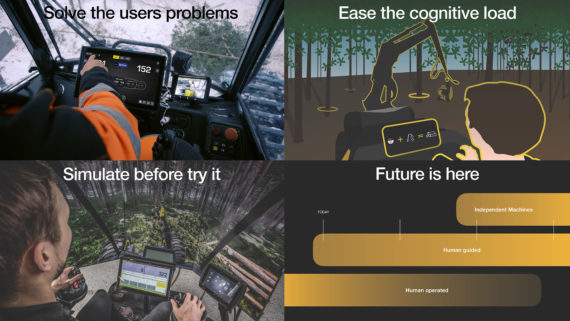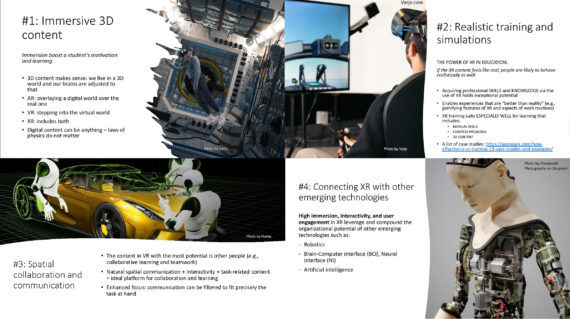The first workshop day was held on the 29th of September 2021 from 9:30 to 14:30. A total of 37 participants gathered in Microsoft Teams for the day. Most of the participants were students from Xamk and LETI, who took part in the five teams of the group working session, but other participants were also welcomed to come in and listen to the keynote speakers.
The workshop’s manager Tero Villman kicked off the day with the inspiring themes of foresight and futures research. He instructed the participating teams on the day’s working methods and upcoming schedules. For the teams, the main goal of the day was to start their work on identifying the opportunities for competence development with new and emerging technologies related to virtual and mixed reality environments. The teams consisted of students from Xamk, LETI and Kudrovo. Each team had a facilitator student from Xamk, who was tasked with coordinating, instructing, encouraging, and documenting the groupwork activities.

After the introduction, the stage was given to the keynote speakers. Panu Johansson, UX Designer at Ponsse Oyj, talked about work that Ponsse does in forestry: “Seeing the wood for the trees – Keeping users at the center of modern forestry”. Ponsse concentrates on sales, service, manufacturing, and technology related to cut-to-length forest machines and services. It is one of the world’s leading manufacturers of forestry equipment.
Johansson presented interesting examples of the complicated processes and the importance of decision making in the field overall and in his work as UX Designer. He also presented how simulation is used at Ponsse and what kind of pros and cons it has. With new efficient methods and technology, customer’s needs can define which kind of timber is produced and less wood is wasted. One of the main challenges in user centered UX design is how to really understand the user, be it the forestry machine driver or the customer.
The second keynote speech was given by Osku Torro, Doctoral Researcher at Tampere University. His topic was “The future is 3D: How XR technology is revolutionizing the automotive and motorsport ecosystems”. His presentation was to give ideas of the technological possibilities we already have in XR – extended reality, including virtual and augmented realities. Natural 3D content and interaction with XR technologies will soon revolutionize how we work, train, and collaborate. When the XR system responds to the user’s actions realistically, they are likely to behave realistically in XR as well. Therefore, acquiring professional skills and knowledge via the use of XR holds exceptional potential.
“The world is 3D, so why not simulate it – or create something that is even more spectacular? How about creating a world where you can have superpowers, and where you level up not your fictional game character but yourself?” – Osku Torro
During Workshop Day I, the teams worked in two sessions with pregiven tasks: Gaining Perspective and Foresight Lense. The workshop’s working process was based on the Futures Clinique method (Ruotsalainen & Heinonen 2013).
The Gaining perspective section utilized a method called the Futures Wheel. The teams work outwards in steps or layers from their chosen topic. Each group member writes what they consider to be a new and interesting impact on their topic. After discussing the ideas on the first layer, the group moves on to the second level impacts and further on to the third layer of ideas.

The Foresight Lense section utilized a method called the Futures table. It is a method to classify impacts per dimension: Political, economic, social, technological, and ecological (PESTE). Each key idea is categorized to the different rows. After the categorizations, the ideas are discussed, and the most important ideas are voted by the group.
Group working started around 10:30 and continued until 14:15 with a quick check up on everyone’s progression. At the conclusion of the day, each team gave a quick overview on what topic they had chosen and how their work had proceeded during the day. To ensure the teams can continue their work until Workshop Day II, they had the opportunity for any questions and clarifications on the process. Tero Villman gave instructions on the follow up work after Day I and before Workshop Day II. He and the keynote speakers will also help the groups in an optional support session before the second workshop day.
At the Futures Lab Workshop Day II on the 13th of October, the groups will complete their work and present it to everyone at the Futures Fair.
Download Panu Johansson’s keynote presentation (11.3MB).
Download Osku Torro’s keynote presentation (2,2MB).
Read more about the series of Futures Lab Workshop: https://www.xamk.fi/en/events/race4scale-future-workshop/
Sources
Heinonen, S., Ruotsalainen, J. Futures Clinique—method for promoting futures learning and provoking radical futures. Eur J Futures Res 1, 7 (2013). https://doi.org/10.1007/s40309-013-0007-4
